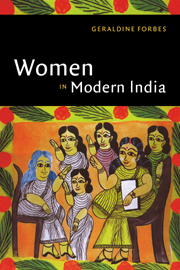Book contents
- Frontmatter
- Introduction
- 1 Reform in the nineteenth century: efforts to modernize women's roles
- 2 Education for women
- 3 The emergence of women's organizations
- 4 The movement for women's rights
- 5 Women in the nationalist movement
- 6 Women's work in colonial India
- 7 A time of transition
- 8 Women in independent India
- Bibliographic essay
- Index
- THE NEW CAMBRIDGE HISTORY OF INDIA
- References
8 - Women in independent India
Published online by Cambridge University Press: 28 March 2008
- Frontmatter
- Introduction
- 1 Reform in the nineteenth century: efforts to modernize women's roles
- 2 Education for women
- 3 The emergence of women's organizations
- 4 The movement for women's rights
- 5 Women in the nationalist movement
- 6 Women's work in colonial India
- 7 A time of transition
- 8 Women in independent India
- Bibliographic essay
- Index
- THE NEW CAMBRIDGE HISTORY OF INDIA
- References
Summary
On August 14, 1947, India and Pakistan gained independence from British rule. Dhanvanthi Rama Rau, president of the All-India Women's Organization in 1946, remembered that time:
All Indians lived through terrible, dark months after Independence. With the Partition of the country and the unexpected, cruel, and unhappy exchanges of populations between Pakistan and India forced on the peoples of both countries, tragedies of a magnitude and intensity beyond the grimmest imagination of any leader were enacted … The rejoicing of our nation on its liberation from nearly two hundred years of colonial rule was turned to mourning at the suffering of our people who were driven from their homes in Pakistan.
On January 30, 1948, Mahatma Gandhi died from an assassin's bullet. Within a year women active in the major women's organizations had lost their dream of a unified country and their beloved leader.
India and Pakistan constructed themselves differently, India as a secular, democratic nation and Pakistan as a religious, authoritarian nation. This chapter will focus only on India and will attempt to draw out the historical roots of problems and issues of Indian women in the period following Independence. Specifically, it will consider women's political role, the relationship of women to the modern economy, and the new women's movement.
WOMEN'S STATUS IN POST-INDEPENDENCA INDIA
The Indian Constitution declared equality a fundamental right. This document also guaranteed equal protection of the law, equal opportunities in public employment, and prohibited discrimination in public places. The Hindu Code, passed as separate Acts between 1955 and 1956, rewrote for Hindus the laws of marriage and divorce, adoption, and inheritance. Adult suffrage added women to the electoral roles and political parties pledged their commitment to women's issues.
- Type
- Chapter
- Information
- Women in Modern India , pp. 223 - 254Publisher: Cambridge University PressPrint publication year: 1996

